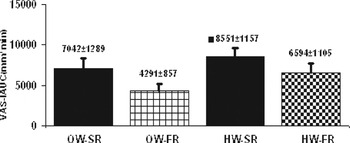There is evidence that eating behaviour has changed from sit down meals to foods often consumed ‘on the go’. This change coincides with the increased prevalence of obesity and its co-morbidities, and has focused research attention on meal frequency and eating rate (ER). There are experimental, observational and population studies on ER, but little evidence of the effects of ER on satiety( Reference Otsuka 1 ). The aim of this study was to assess if ER affects the postprandial satiety responses, in healthy (HW) and overweight/obese (OW) subjects.
A favourable ethical opinion was obtained from the University Ethics Committee. Fourteen participants, 7 OW (body mass index (BMI) 31.7 kg/m2, sd 6.6) and 7HW (BMI 20.3 kg/m2, sd 2), mean age 22.1 years (sd 1.7), were randomised to a 2-way crossover design study of two controlled eating rates. Baseline anthropometric measurements were taken, then isoenergetic meals (610 kcal, 37 g protein, 85 g CHO, 12.2 g fat, 5.8 g fibre) were consumed slowly (SR) and at a fast rate (FR), separated by at least seven days, with fasting and regular postprandial measurements of perceived satiety measured by visual analogue scales (VAS). Statistical analysis was carried out using graph pad prism with paired t test (eating rate) and two-factor ANOVA (factors treatment and group) for perceived satiety data.
In the FR leg, the OW group ate at a significantly faster rate (5±0.8 min) than the HW group (8.3±0.4 min, p=0.004). Perceived satiety results by VAS score showed an overall trend of the VAS Incremental Area Under the Curve (IAUC) suggesting that both weight-groups had greater perceived fullness when eating at a slow rate (p=0.08, Figure 1). Significant correlations were observed between eating time and BMI (r=−0.7001, p=0.0053, Figure 2), visceral fat score (r=−0.8213, p=0.0003) and trunk fat percentage (r=−0.6030, p=0.0225) within the FR leg, whereas no significant correlations where observed for the SR leg. The observed associations between body composition and ER, are original and previously unpublished findings.

Fig. 1. VAS-IAUC for perceived fullness (mean±sem).

Fig. 2. FR eating time (min) correlation with BMI (n=14).
The OWFR group consumed the meal at a faster ER than the HWFR group and the trend towards increased perceived fullness when eating at a slow rate are in agreement with current literature( Reference Andrade, Greene and Melanson 2 , Reference Laessle, Lehrke and Duckers3 ). The correlations within the FR leg between eating time and body composition suggest that participants who eat at a faster rate have a greater risk of a higher BMI, visceral fat score and trunk fat percentage, making this the first laboratory study to suggest a positive correlation between fast ER and these measurements.
This study suggests that rate of eating may contribute to overeating or overweight via delayed or reduced appetite control. This pilot study provides data to calculate sample size and power for future ER studies in OW and HW subjects, and evidence for the methodology to produce pilot data in diabetic/pre-diabetic subjects, where ER and may have benefits to longer term appetite and glycaemic control.




